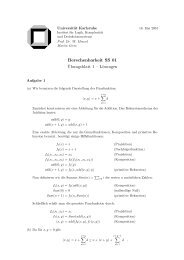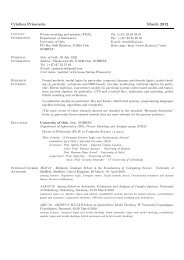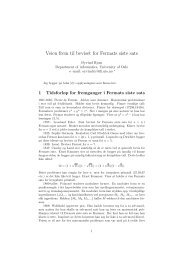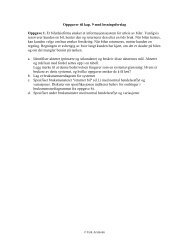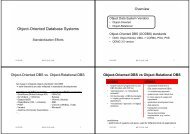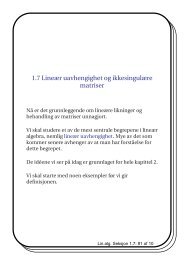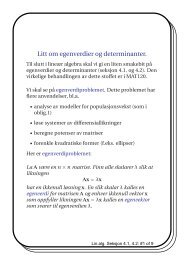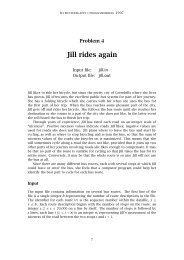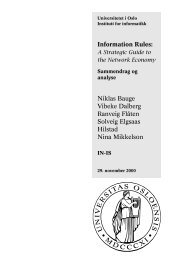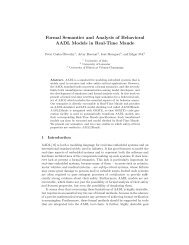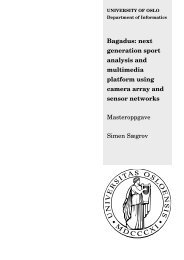Timed CTL Model Checking in Real-Time Maude⋆ - IfI
Timed CTL Model Checking in Real-Time Maude⋆ - IfI
Timed CTL Model Checking in Real-Time Maude⋆ - IfI
You also want an ePaper? Increase the reach of your titles
YUMPU automatically turns print PDFs into web optimized ePapers that Google loves.
22 D. Lepri, E. Ábrahám, and P. Cs. Ölveczky<br />
(ii) For the case d π′<br />
i<br />
k ∈ I2 = I\I1 let v be the number of states <strong>in</strong> π pre′<br />
i . We<br />
show that k − v is a proper <strong>in</strong>dex for the satisfaction of the bounded<br />
until along π ′′<br />
j .<br />
We observe that t π′′<br />
j<br />
l<br />
T K, t π′′<br />
j<br />
i = tπ′<br />
l+v<br />
i<br />
for all l. Therefore, T K, tπ′<br />
k |=c ϕ2 implies<br />
k−v |=c ϕ2. S<strong>in</strong>ce d π′ i<br />
k ∈ I2 we have d π′ i<br />
k ≥ ml¯r + d2 + d3 and<br />
thus d π′′ j<br />
i<br />
k−v = dπ′<br />
k − d2 ≥ ml¯r + d3, i.e., the duration of π ′′<br />
j until the<br />
(k − v)-th state is above the lower bound of I. It is easy to see that this<br />
duration is also below the upper bound (d π′<br />
i<br />
k is below the upper bound<br />
and d π′′ j<br />
i<br />
k−v = dπ′<br />
k − d2 < d π′ i<br />
k ).<br />
F<strong>in</strong>ally, T K, t π′<br />
i<br />
l+v |=c ϕ1 implies T K, t π′′<br />
j<br />
l |=c ϕ1 for all l < k−v Therefore,<br />
the <strong>in</strong>dex (k − v) is appropriate to show that the path π ′′<br />
j satisfies the<br />
bounded until property.<br />
“⇐”: This proof case is quite analogous to the “⇐” case of the existentially<br />
quantified bounded until. The proof structure is illustrated <strong>in</strong> Figure 4.<br />
Assume that R, t π j |=c A ϕ1 UI ϕ2 holds. Then by def<strong>in</strong>ition for all paths<br />
πj ∈ tfPaths T K(t π j ) there is a time ref<strong>in</strong>ement π′ j ∈ tfPaths T K(t π j ) of πj and<br />
an <strong>in</strong>dex k s.t. d π′<br />
j<br />
j<br />
k ∈ I, T K, tπ′<br />
k |=c ϕ2, and T K, t π′<br />
j<br />
l |=c ϕ1 for all 0 ≤ l < k.<br />
We show that R, tπ i |=c A ϕ1 UI ϕ2 holds. Let πi ∈ tfPathsT K(tπ i ) be a path.<br />
Due to time robustness, πi has a time ref<strong>in</strong>ement π ′ i ∈ tfPathsT K(tπ i ) which<br />
conta<strong>in</strong>s the state tπ j at time po<strong>in</strong>t d2, and <strong>in</strong> case the upper bound of I is<br />
f<strong>in</strong>ite also a state t∗∗ at time po<strong>in</strong>t mu¯r. Note that time robustness assures<br />
that the state at time po<strong>in</strong>t d2 is tπ j .<br />
Let π pre′<br />
i and πj be the prefix resp. suffix of π ′ i<br />
end<strong>in</strong>g resp. start<strong>in</strong>g at<br />
time po<strong>in</strong>t d2, i.e., at the state tπ j . From R, tπj |=c A ϕ1 UI ϕ2 we conclude<br />
that there is a time ref<strong>in</strong>ement π ′ j of πj and an <strong>in</strong>dex k such that d π′<br />
j<br />
k<br />
T K, t π′<br />
j<br />
∈ I,<br />
k |=c ϕ2, and T K, t π′<br />
j<br />
l |=c ϕ1 for all 0 ≤ l < k.<br />
Let π ′′<br />
i be the concatenation of πpre′ i and π ′ j . Note that π′′ i is a time ref<strong>in</strong>ement<br />
of πi. We show that the bounded until holds along π ′′<br />
i . We dist<strong>in</strong>guish<br />
between k = 0 and k > 0.<br />
k = 0 For the case k = 0 notice that t π′<br />
j<br />
0 = tπj and thus T K, tπj |=c ϕ2. Us<strong>in</strong>g the<br />
path π, by <strong>in</strong>duction we get T K, tπ i |=c ϕ2. Furthermore, s<strong>in</strong>ce d π′<br />
j<br />
0 = 0<br />
and d π′ j<br />
0 ∈ I, the lower bound of I must be 0. I.e., the <strong>in</strong>dex 0 satisfies<br />
the condition for the bounded until on the path π ′′<br />
i .<br />
k > 0 Otherwise, if k > 0 then T K, tπ j |=c ϕ1 and we get by <strong>in</strong>duction that<br />
T K, t π′′<br />
i<br />
l |=c ϕ1 for all l < v (i.e., all states <strong>in</strong> the prefix π pre′<br />
i<br />
end<strong>in</strong>g at tπ j at time po<strong>in</strong>t d2 satisfy ϕ1).<br />
of π ′′<br />
i<br />
(i) If the upper bound of I is INF then from T K, t π′′<br />
j<br />
k |=c ϕ2 and t π′′<br />
j<br />
k =<br />
t π′<br />
i<br />
k+v<br />
i<br />
we conclude that T K, tπ′<br />
k+v |=c ϕ2. Furthermore, d π′′<br />
j<br />
k is above<br />
the lower bound of I and d π′<br />
i<br />
k+v<br />
j<br />
= dπ′′<br />
k + d2, i.e., d π′<br />
i<br />
k+v<br />
∈ I.



